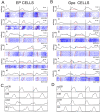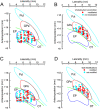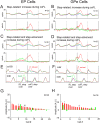Contribution of the Entopeduncular Nucleus and the Globus Pallidus to the Control of Locomotion and Visually Guided Gait Modifications in the Cat
- PMID: 32377665
- PMCID: PMC7391415
- DOI: 10.1093/cercor/bhaa106
Contribution of the Entopeduncular Nucleus and the Globus Pallidus to the Control of Locomotion and Visually Guided Gait Modifications in the Cat
Abstract
We tested the hypothesis that the entopeduncular (EP) nucleus (feline equivalent of the primate GPi) and the globus pallidus (GPe) contribute to both the planning and execution of locomotion and voluntary gait modifications in the cat. We recorded from 414 cells distributed throughout these two nuclei (referred to together as the pallidum) while cats walked on a treadmill and stepped over an obstacle that advanced towards them. Neuronal activity in many cells in both structures was modulated on a step-by-step basis during unobstructed locomotion and was modified in the step over the obstacle. On a population basis, the most frequently observed change, in both the EP and the GPe, was an increase in activity prior to and/or during the swing phase of the step over the obstacle by the contralateral forelimb, when it was the first limb to pass over the obstacle. Our results support a contribution of the pallidum, in concert with cortical structures, to the control of both the planning and the execution of the gait modifications. We discuss the results in the context of current models of pallidal action on thalamic activity, including the possibility that cells in the EP with increased activity may sculpt thalamo-cortical activity.
Keywords: basal ganglia; entopeduncular nucleus; globus pallidus; pallidum; visually guided gait modification.
© The Author(s) 2020. Published by Oxford University Press. All rights reserved. For permissions, please e-mail: journals.permission@oup.com.
Figures












References
-
- Alexander GE, Delong MR, Strick PL. 1986. Parallel organization of functionally segregated circuits linking basal ganglia and cortex. Annu Rev Neurosci. 9:357–381. - PubMed
-
- Allen GI, Tsukuhara N. 1974. Cerebrocerebellar communication systems. Physiol Rev. 54:957–1006. - PubMed
-
- Amos A, Armstrong DM, Marple-Horvat DE. 1990. Changes in the discharge patterns of motor cortical neurones associated with volitional changes in stepping in the cat. Neurosci Lett. 109:107–112. - PubMed
-
- Anderson ME, Horak FB. 1985. Influence of the globus pallidus on arm movements in monkeys. III. Timing of movement-related information. J Neurophysiol. 54:433–448. - PubMed
-
- Anderson ME, Turner RS. 1991. A quantitative analysis of pallidal discharge during targeted reaching movement in the monkey. Exp Brain Res. 86:623–632. - PubMed
Publication types
MeSH terms
Grants and funding
LinkOut - more resources
Full Text Sources
Miscellaneous

